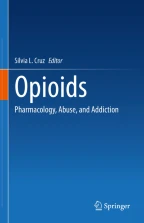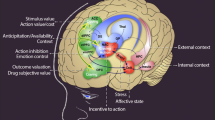A Brief History of Opioids and the Evolution of Concepts Associated with Substance Use Disorders

This chapter provides an overview of the history of opioids and people’s different relationships with them across time and geography. It begins with the origins of the poppy flower, the recreational and medical use of opium in ancient cultures and Asia, and its pathway to European users. This chapter also reviews the different medicinal opium preparations (e.g., beverages, syrups, concoctions) used until the nineteenth century and the Opium Wars between England and China. Another section describes the discovery of morphine, the development of semisynthetic and synthetic opioids, the identification of endogenous opioid peptides, and the pharmacological characterization of opioid receptor subtypes. Finally, this chapter provides a brief description of the role of opioids in modern societies and reviews how basic concepts related to opioids and opioid use disorders (OUDs) have evolved through time.
This is a preview of subscription content, log in via an institution to check access.
Access this chapter
Subscribe and save
Springer+ Basic
€32.70 /Month
- Get 10 units per month
- Download Article/Chapter or eBook
- 1 Unit = 1 Article or 1 Chapter
- Cancel anytime
Buy Now
Price includes VAT (France)
eBook EUR 85.59 Price includes VAT (France)
Softcover Book EUR 105.49 Price includes VAT (France)
Hardcover Book EUR 105.49 Price includes VAT (France)
Tax calculation will be finalised at checkout
Purchases are for personal use only
Similar content being viewed by others

Opiates, Opioids Intoxication
Chapter © 2018

Opioid Addiction: Short- and Long-Acting Opioids
Chapter © 2015

The changing opioid crisis: development, challenges and opportunities
Article 04 February 2020
References
- Jesus A, Bonhomme V, Evin A, Ivorra S, Soteras R, Salavert A, et al. A morphometric approach to track opium poppy domestication. Sci Rep [Internet]. 2021;11(1):9778. Available from: https://doi.org/10.1038/s41598-021-88964-4ArticleGoogle Scholar
- Heyman GM, Mims V. What addicts can teach us about addiction: a natural history approach. In: Heather N, Segal G, editors. Addiction and choice: rethinking the relationship [Internet]. Oxford University Press; 2016. p. 385–408. Available from: http://search.ebscohost.com/login.aspx?direct=true&db=psyh&AN=2016-47926-021&site=ehost-live. ChapterGoogle Scholar
- Booth M. Opium: a history. Simon & Schuster Ltd; 1996. p. 359. Google Scholar
- López Eire A, Cortés Gabaudan F. Hierbas y plantas: Adormidera. Dioscórides interactivo. Sobre los remedios medicinales-manuscrito de Salamanca, 2006. Google Scholar
- Aziz E, Nathan B, McKeever J. Anesthetic and analgesic practices in Avicenna’s Canon of Medicine. Am J Chin Med. 2000;28(1):147–51. ArticleCASPubMedGoogle Scholar
- Heydari M, Hashempur MH, Zargaran A. Medicinal aspects of opium as described in Avicenna’s Canon of Medicine. Acta Med Hist Adriat [Internet]. 2013 [cited 2021 Sep 15];11(1):101–12. Available from: https://pubmed.ncbi.nlm.nih.gov/23883087/
- Robinson S, Adinoff B. The classification of substance use disorders: historical, contextual, and conceptual considerations. Behav Sci (Basel) [Internet]. 2016;6(3):1–23. Available from: http://www.mdpi.com/2076-328X/6/3/18Google Scholar
- Fernandez H, Libby TA. Heroin: its history, pharmacology, and treatment, vol. 148. 2nd ed. Hazelden Publishing; 2011. p. 148–62. Google Scholar
- University of Southern California. Lin Zexu (LinTse-hsu) writing to Britain’s Queen Victoria to Protest the Opium Trade, 1839 | US-China Institute [Internet]. US-China Institute. 2021 [cited 2021 Sep 15]. Available from: https://china.usc.edu/lin-zexu-lintse-hsu-writing-britains-queen-victoria-protest-opium-trade-1839
- Presley CC, Lindsley CW. DARK classics in chemical neuroscience: opium, a historical perspective. ACS Chem Neurosci. 2018;9(10):2503–18. ArticleCASPubMedGoogle Scholar
- Osler W. A Contribution to medical history: Thomas Dover, M.B. (of Dover’s Powder), physician and buccaneer. Lancet [Internet]. 1896;147(3775):4–7. Available from: https://linkinghub.elsevier.com/retrieve/pii/S0140673601606858
- The Lancet Commission. Sanitary condition of pur public schools [Internet]. 1875. Available from: https://ia800708.us.archive.org/view_archive.php?archive=/22/items/crossref-pre-1909-scholarly-works/10.1016%252Fs0140-6736%252802%252930549-x.zip&file=10.1016%252Fs0140-6736%252802%252930644-5.pdf.
- Engels F. The conditions of the working class in England, Oxford World’s classics. Oxford University Press; 1844. Google Scholar
- Lawrence G. The hypodermic syringe. Lancet [Internet]. 2002;359(9311):1074. Available from: https://linkinghub.elsevier.com/retrieve/pii/S0140673602081011.
- Brook K, Bennett J, Desai SP. The chemical history of Morphine: an 8000-year journey, from resin to de-novo synthesis. J Anesth Hist [Internet]. 2017;3(2):50–55. Available from: https://doi.org/10.1016/j.janh.2017.02.001.
- McCoy A. From free trade to prohibition: a critical history of the modern Asian opium trade. Fordham Urban Law J. 2000;28(1):307–49. Google Scholar
- Austin GA. Perspectives on the history of psychoactive substance use [Internet]. Rockvile: National Institute on Drug Abuse; 1978. 280 p. Available from: https://books.google.com.mx/books?hl=es&lr=&id=UQE3rikfXSgC&oi=fnd&pg=PR5&dq=Perspectives+on+the+history+of+psychoactive+substance+use&ots=oS59dkrNbj&sig=kbFIvuZEX3ujqIfg_-WVChrpoKA.
- Brownstein MJ. A brief history of opiates, opioid peptides, and opioid receptors. Proc Natl Acad Sci U S A [Internet]. 1993;90(12):5391–3. Available from: https://www.mendeley.com/viewer/?fileId=2748b363-305f-4311-6a3c-171b74a43332&documentId=6b4dc5ca-8403-3307-9265-ceb50db3e6ecArticleCASGoogle Scholar
- Campbell ND. "A new deal for the drug addict": The Addiction Research Center, Lexington, Kentucky. J Hist Behav Sci [Internet]. 2006;42(2):135–57. Available from: https://onlinelibrary.wiley.com/doi/10.1002/jhbs.20167ArticleGoogle Scholar
- Corbett AD, Henderson G, McKnight AT, Paterson SJ. 75 years of opioid research: the exciting but vain quest for the Holy Grail. Br J Pharmacol [Internet]. 2006;147(SUPPL. 1):153–62. Available from: https://onlinelibrary.wiley.com/doi/10.1002/jhbs.20167ArticleGoogle Scholar
- Kosterlitz HW, Waterfield AA. The effect of the interval between electrical stimuli on the acetylcholine output of the myenteric plexus-longitudinal muscle preparation of the guinea-pig ileum. Br J Pharmacol [Internet]. 1970;40(1):162P–3P. Available from: https://www.ncbi.nlm.nih.gov/pmc/articles/PMC1702700/CASPubMedPubMed CentralGoogle Scholar
- Cox BM. A concise review of concepts in opioid pharmacology up to the discovery of endogenous opioids. Mol Pharmacol [Internet]. 2020;98(4):392–400. Available from: http://molpharm.aspetjournals.org/lookup/doi/10.1124/mol.120.119420ArticleCASGoogle Scholar
- Harris LS, May EL. Historical introduction and review of chemistry. Drug Alcohol Depend [Internet]. 1985;14(3–4):227–32. Available from: https://linkinghub.elsevier.com/retrieve/pii/0376871685900584ArticleCASGoogle Scholar
- Pert CB, Pasternak G, Snyder SH. Opiate agonists and antagonists discriminated by receptor binding in brain. Science (80-). 1973;182(4119):1359–61. ArticleCASGoogle Scholar
- Pert CB, Snyder SH. Opiate receptor binding of agonists and antagonists affected differentially by sodium. Mol Pharmacol. 1974;10(6):868–79. CASGoogle Scholar
- Snyder SH, Pasternak GW. Historical review: opioid receptors. Trends Pharmacol Sci. 2003;24(4):198–205. ArticleCASPubMedGoogle Scholar
- Maurice T, Su TP. The pharmacology of sigma-1 receptors. Pharmacol Ther [Internet]. 2009;124(2):195–206. Available from: https://doi.org/10.1016/j.pharmthera.2009.07.001.
- McCoy AW. Coercion and its unintended consequences: a study of heroin trafficking in Southeast and South West Asia. Crime Law Soc Chang. 2000;33(3):191–224. ArticleGoogle Scholar
- Ciccarone D. The triple wave epidemic: supply and demand drivers of the U.S. opioid overdose crisis. Int J Drug Policy. 2019;71:183–8. ArticlePubMedPubMed CentralGoogle Scholar
- Bardwell G, Boyd J, Tupper KW, Kerr T. "We don’t got that kind of time, man. We’re trying to get high!": exploring potential use of drug checking technologies among structurally vulnerable people who use drugs. Int J Drug Policy. 2019;71:125–32. ArticlePubMedPubMed CentralGoogle Scholar
- Wilson N, Kariisa M, Seth P, Smith H, Davis NL. Drug and opioid-involved overdose deaths — United States, 2017–2018. MMWR Morb Mortal Wkly Rep [Internet]. 2020;69(11):290–7. Available from: https://www.cdc.gov/nchs/data/nvsr/nvsr61/ArticleGoogle Scholar
- Terry NR. Structural determinism amplifying the opioid crisis : It’s the healthcare, stupid !*. Northeast Univ Law Rev [Internet]. 2018;11(1):315–71. Available from: https://www.samhsa.gov/data/sites/default/files/NSDUH-Google Scholar
- Martin CS, Chung T, Langenbucher JW. Historical and cultural perspectives on substance use and substance use disorders. In: Sher KJ, editor. The Oxford handbook of substance use disorders, volume 1 [Internet]. Oxford University Press; 2014. p. 29–49. Available from: http://search.ebscohost.com/login.aspx?direct=true&db=psyh&AN=2016-26127-001&site=ehost-live. Google Scholar
- Nathan PE, Conrad M, Skinstad AH. History of the concept of addiction. Ann Rev Clin Psychol [Internet]. 2016;12(1):29–51. Available from: http://www.annualreviews.org/doi/10.1146/annurev-clinpsy-021815-093546ArticleGoogle Scholar
- Cotman CW, McGaugh JL. Behavioral Neuroscience. New York: Academic Press; 1980. p. 857. Google Scholar
- American Psychiatric Association. Diagnostic and statistical manual of mental disorders. 4th ed. Washington, DC: American Psychiatric Association; 2000. p. 866. Google Scholar
- Wu L-T, Ringwalt CL, Yang C, Reeve BB, Pan J-J, Blazer DG. Construct and differential item functioning in the assessment of prescription opioid use disorders among American adolescents. J Am Acad Child Adolesc Psychiatry [Internet]. 2009;48(5):563–72. Available from: https://linkinghub.elsevier.com/retrieve/pii/S0890856709600733ArticleGoogle Scholar
- Wu L-T, Woody GE, Yang C, Pan J-J, Blazer DG. Abuse and dependence on prescription opioids in adults: a mixture categorical and dimensional approach to diagnostic classification. Psychol Med [Internet]. 2011;41(3):653–64. Available from: https://www.cambridge.org/core/product/identifier/S0033291710000954/type/journal_articleArticleGoogle Scholar
- American Psychiatric Association. Diagnostic and statistical manual of mental disorders [Internet]. 5th ed. Washington, DC: American Psychiatric Publishing; 2013. p. 947. Available from: https://linkinghub.elsevier.com/retrieve/pii/B0126574103004578BookGoogle Scholar
- Volkow ND, Blanco C. Medications for opioid use disorders: clinical and pharmacological considerations. J Clin Invest [Internet]. 2020;130(1):10–3. Available from: https://www.jci.org/articles/view/134708ArticleCASGoogle Scholar
- Poznyak V, Reed GM, Medina-Mora ME. Aligning the ICD-11 classification of disorders due to substance use with global service needs. Epidemiol Psychiatr Sci. 2018;27(3):212–8. ArticleCASPubMedGoogle Scholar
- World Health Organization. ICD-11 - ICD-11 for mortality and morbidity statistics [Internet]. International Statistical Classification of diseases and related health problems. 2019. Available from: https://icd.who.int/browse11/l-m/en#/http%3A%2F%2Fid.who.int%2Ficd%2Fentity%2F1602669465.
- Kalivas PW, Volkow ND. The neural basis of addiction: a pathology of motivation and choice. Am J Psychiatry [Internet]. 2005;162(8):1403–1413. Available from: http://psychiatryonline.org/doi/abs/10.1176/appi.ajp.162.8.1403.
Author information
Authors and Affiliations
- Department of Pharmacobiology, Cinvestav, Mexico City, Mexico Silvia L. Cruz
- Opioids Working Group, Global Studies Seminar, Faculty of Medicine, National Autonomous University of Mexico (UNAM), Mexico City, Mexico Silvia L. Cruz & Claudia Rafful
- Faculty of Psychology, UNAM, Mexico City, Mexico Claudia Rafful
- Center for Global Mental Health Research, National Institute of Psychiatry Ramón de la Fuente Muñiz (INPRM), Mexico City, Mexico Claudia Rafful
- Silvia L. Cruz


